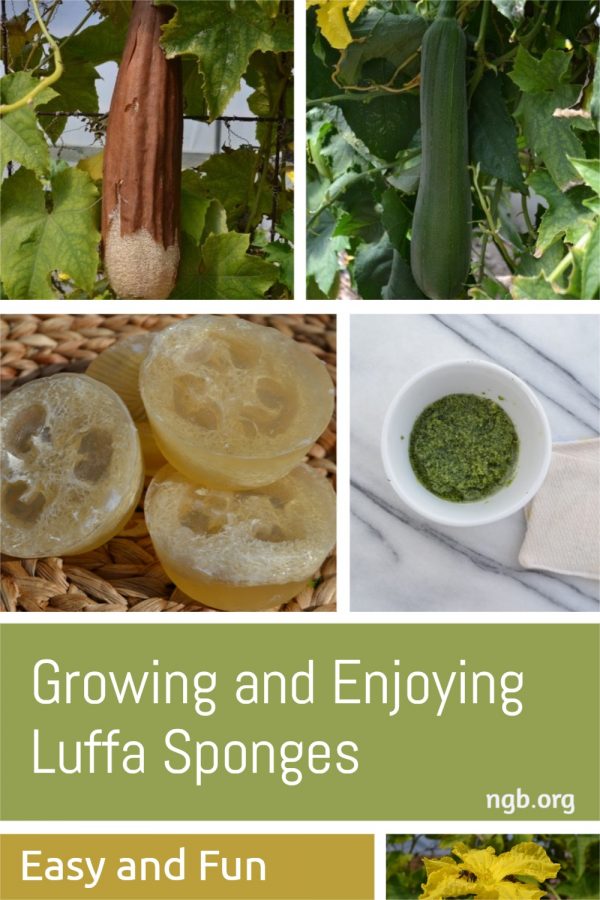Originally appeared at National Gardening Bureau
Growing your own supply of natural sponges is easy and fun.
Luffa (loofah) sponges do not come from the sea but from the vegetable garden. These natural scrubbers belong in the family of plants that include gourds, squashes, pumpkins, cucumbers, and melons. They are most closely related to cucumbers in appearance and growing habits. They can be used as household scrubbers, body exfoliators, and young luffas are even edible and delicious when added to simple dishes and stir-fry recipes. If you added luffas to your garden this year Fall is the time for harvest. They may also be seen for sale at local farm stands and natural food stores. You may also find local seeds for sale that you can save for next year and start your own healthy skincare spot in your garden.
Here are a few simple recipes for you to enjoy:
Green Luffa Skin Cleanser
The green outer skin of the luffa plant is cleansing and naturally astringent much like cucumber peels and can be used to cleanse and freshen your skin. This simple skin cleanser is a good replacement for soap and can be used by all skin types. Because it contains fresh foods it should be stored in the refrigerator between uses. Yield: 8 ounces
Ingredients:
- 1 cup green luffa peels
- 1 Tablespoon aloe vera gel
- 1 teaspoon raw honey
- 1-2 Tablespoons water
Directions:
Place all ingredients in a food processor or blender and process until you have a smooth, green mixture. Pour into a clean container with a tight-fitting lid.
Massage into damp skin and rinse well with warm water.
Luffa Soap
These are gentle scrubbing bars that are useful in cleaning your hands after a day of gardening. You can also use them to cleanse your whole body but be careful around sensitive areas. The natural luffa sponge helps exfoliate dead skin cells and surface impurities, leaving your skin clean, soft, and smooth. Do not use this soap to wash your face, as it may be too harsh. Use a serrated bread knife to slice the dried luffa gourd. You can use a variety of kitchen items as soap molds: muffin tins, plastic dishes, mini loaf pans, and clean food containers. Yield: 8 ounces, 3-4 bars of luffa soap
Ingredients:
- 2 bars of pure natural soap, such as Castile, or coconut oil
- 2 Tablespoons vegetable glycerin
- 1 Tablespoon water
- 4 slices dried luffa sponge, 1/2 inch thick
Directions:
Place the luffa slices on an oiled cookie sheet or inside a greased soap mold. In a double boiler gently heat the soap, glycerin, and water until you have a thick mixture and all the soap is melted. Spoon the melted soap inside your luffa slices and allow it to harden. Trim your soaps with a sharp knife.
Use as you would a luffa sponge or any scrubbing bar of soap. Avoid broken skin or sensitive areas.
Scrambled Eggs and Luffa
Young luffa gourds or also called “Chinese okra” can be found in some Asian markets and make a tasty addition to stir fry recipes. You can also use your own young plants in this recipe. Pick them when they are green and around 6 inches in length. Slice them on the diagonal in small one-inch pieces. Yield: 16 ounces, 2 servings
Ingredients:
- 1 Tablespoon vegetable oil
- 2 teaspoons minced garlic
- 2 cups luffa gourd, peeled and cut into 1-inch slices
- 2 large eggs beaten
- Salt and pepper to taste
Directions:
Heat oil in a large skillet over medium heat. Add garlic and stir until light brown and aromatic. Add luffa and stir until softened about 1-2 minutes. Add eggs and cook until set. Season with salt and pepper. Serve with rice or steamed vegetables.
Are you going to grow luffa in your garden?
Written By: Janice Cox
Author of: Beautiful Luffa
“This post is provided as an educational/inspirational service of the National Garden Bureau and our members. Please credit and link to National Garden Bureau and author member when using all or parts of this article.”







